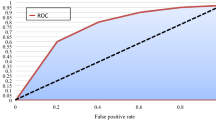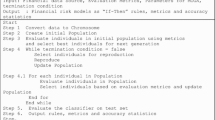Abstract
The traditional corporate financial diagnosis method is susceptible to the choice of accounting policies, and there are serious lags, one-sidedness and limitations. A financial management information system based on improved genetic algorithm is proposed based on the financial management information system data mining and clustering analysis model framework, and based on the financial analysis related knowledge. By adopting the event-driven architecture, a financial management information system model based on data mining technology is constructed, which not only enables the data warehouse and data mining technology to play a role in decision support, but also enables the financial information and non-financial information of enterprises to be fully utilized. By extracting financial data, using the above decision tree classification algorithm for data mining, classifying tests according to subject categories and business processes, and evaluating the accuracy of the prediction results, and then determining whether the classification algorithm is selected. The test and analysis of the national tax financial analysis system were completed, and three public data sets and three national tax financial expenditure data sets were selected, and the algorithm was tested on the experimental platform. The test results show that the algorithm show good performance for large-scale data sets, especially financial expenditure data sets, and the test accuracy rate is not only stable but also maintains a relatively high range.








Similar content being viewed by others
Change history
14 November 2022
This article has been retracted. Please see the Retraction Notice for more detail: https://doi.org/10.1007/s10257-022-00587-y
References
Bider I, Jalali A (2016) Agile business process development: why, how and when—applying Nonaka’s theory of knowledge transformation to business process development. Inf Syst e-Bus Manag 14(4):693–731
Breuker D, Delfmann P, Dietrich HA et al (2014) Graph theory and model collection management: conceptual framework and runtime analysis of selected graph algorithms. Inf Syst e-Bus Manag 12(1):69–106
Cavuoti S, Garofalo M, Brescia M et al (2014) Astrophysical data mining with GPU. A case study: genetic classification of globular clusters. New Astron 26(1):12–22
Chang HH, Lin CL (2015) A novel information technology of load events detection for the energy management information systems. Inf Syst e-Bus Manag 13(2):289–308
Chi Q, Fu XL, Pan YN et al (2014) The optimization model of in job-shop scheduling problem with alternative machines based on improved genetic algorithm. Appl Mech Mater 607(4):569–572
Das SP, Padhy S (2018) A novel hybrid model using teaching–learning-based optimization and a support vector machine for commodity futures index forecasting. Int J Mach Learn Cybern 9(1):97–111
Engel R, Krathu W, Zapletal M et al (2016) Analyzing inter-organizational business processes. Inf Syst e-Bus Manag 14(3):577–612
Guo W, Xu T, Lu Z (2016) An integrated chaotic time series prediction model based on efficient extreme learning machine and differential evolution. Neural Comput Appl 27(4):883–898
Iquebal AS, Pal A, Ceglarek D et al (2014) Enhancement of Mahalanobis–Taguchi system via rough sets based feature selection. Expert Syst Appl 41(17):8003–8015
Kaiser C, Kröckel Johannes, Bodendorf F (2013) Simulating the spread of opinions in online social networks when targeting opinion leaders. Inf Syst e-Bus Manag 11(4):597–621
Ke Q, Shaofei W, Wang M, Zou Y (2018) Evaluation of developer efficiency based on improved DEA model. Wirel Pers Commun 12(4):3843–3849
Kridel D, Dolk D (2013) Automated self-service modeling: predictive analytics as a service. Inf Syst e-Bus Manag 11(1):119–140
Macas M (2014) Binary social impact theory based optimization and its applications in pattern recognition. Neurocomputing 132(7):85–96
Mikalef P, Pappas IO, Krogstie J et al (2017) Big data analytics capabilities: a systematic literature review and research agenda. Inf Syst e-Bus Manag 2:1–32
Ng KH, Khor KC (2015) StockProF: a stock profiling framework using data mining approaches. Inf Syst e-Bus Manag 15(1):1–20
Singh P (2017) A brief review of modeling approaches based on fuzzy time series. Int J Mach Learn Cybernet 8(2):397–420
Tong X, Lin J, Ji Y et al (2017) Global optimization of wireless seismic sensor network based on the Kriging model and improved particle swarm optimization algorithm. Wirel Pers Commun 95(3):1–20
Wu S (2015) A traffic motion object extraction algorithm. Int J Bifurc Chaos 25(14):Article Number 1540039
Wu S, Wang M, Zou Y (2018) Research on internet information mining based on agent algorithm. Future Gener Comput Syst 86:598–602
Xiao Y, Liu JJ, Hu Y et al (2014) A neuro-fuzzy combination model based on singular spectrum analysis for air transport demand forecasting. J Air Transp Manag 39(39):1–11
Xie Y, Takala J, Liu Y et al (2015) A combinatorial optimization model for enterprise patent transfer. Inf Technol Manag 16(4):327–337
Younus ZS, Mohamad D, Saba T et al (2015) Content-based image retrieval using PSO and k-means clustering algorithm. Arab J Geosci 8(8):6211–6224
Zacharewicz G, Diallo S, Ducq Y et al (2016) Model-based approaches for interoperability of next generation enterprise information systems: state of the art and future challenges. Inf Syst e-Bus Manag 15(4):1–28
Zoet M, Versendaal J (2014) Defining collaborative business rules management solutions: framework and method. Inf Syst e-Bus Manag 12(4):543–565
Author information
Authors and Affiliations
Corresponding author
Additional information
Publisher's Note
Springer Nature remains neutral with regard to jurisdictional claims in published maps and institutional affiliations.
This article has been retracted. Please see the retraction notice for more detail: https://doi.org/10.1007/s10257-022-00587-y"
Rights and permissions
Springer Nature or its licensor (e.g. a society or other partner) holds exclusive rights to this article under a publishing agreement with the author(s) or other rightsholder(s); author self-archiving of the accepted manuscript version of this article is solely governed by the terms of such publishing agreement and applicable law.
About this article
Cite this article
Li, W., Zhou, Q., Ren, J. et al. RETRACTED ARTICLE: Data mining optimization model for financial management information system based on improved genetic algorithm. Inf Syst E-Bus Manage 18, 747–765 (2020). https://doi.org/10.1007/s10257-018-00394-4
Received:
Revised:
Accepted:
Published:
Issue Date:
DOI: https://doi.org/10.1007/s10257-018-00394-4




